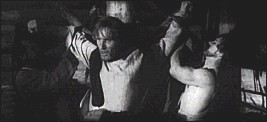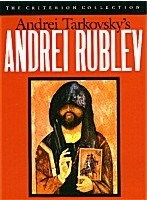![[Deep Focus]](../../../flicker/dvd/logo.gif) |
|||
|
ANDREI RUBLEV |
|
Directed by Andrei Tarkovsky Written by Tarkovsky and Andrei Konchalovsky Starring Anatoli Solonitsyn Russia, 1966
| |
|
Among the greatest of all historical epics is Andrei Tarkovsky's Andrei Rublev, a 15th Century biopic that's hardly an epic at all in the conventional sense. It may be more descriptive to call Rublev an elliptical masterpiece, a narrative whose elisions offer new perspectives on the events it chooses to depict. The film's mysterious prologue sets the tone for what is to follow. A group of peasants struggles with the moorings of a hot-air balloon tethered outside a church. Before they let it loose, one man climbs aboard from the top of the church tower. As the balloon sails free, the camera itself suddenly becomes airborne, floating above the earth to show us what he sees. The exhilarating sequence is, of course, fraught with danger, and the experiment ends badly. We never learn any more about that man or his ill-fated flight. Instead, we're introduced to a group of three monks leaving Moscow. One remarks that the city will have enough painters without them, and thus we may speculate that one of the three is the title character, a renowned Russian icon painter. If one of these men is Rublev, he's not immediately identified, leaving us uncertain about whose story this is, anyway. That's the condition under which we'll view the rest of the film -- as each of its seven segments begins, the viewer is again thrown off-balance. Rublev's presence isn't even a constant, as some sequences unfold without him. We expect him to show up eventually, as a bit player or even a spectator, but each vignette is absorbing in its own right.
One such scene has Rublev stumbling across a pagan ritual charged with carnality. His curiosity is overwhelming -- as he observes one couple making love, he momentarily forgets where he's standing and his robes literally catch on fire. He's eventually captured and tied to a cross, a literal echo of his earlier imagining of a passion play, despite his protest that the sinners will burn in hell for their transgression. Later, he'll refuse to paint the Last Judgment, despite a colleague's matter-of-fact enthusiasm over a particularly threatening manifestation of Satan. The final crisis comes when Rublev kills a man during the pillage of the town of Vladimir by Tatar invaders. As penance, Rublev befriends the girl whose would-be rapist he slew, ceases painting and vows silence. The question of how Rublev will gain the werewithal to work again hangs over the film's final segment, in which a young man is recruited to cast a huge bell for the Prince. As a Soviet filmmaker, Tarkovsky works in the shadow of Eisenstein, but his shooting style seems influenced less by Eisensteinian montage and more by the fluid camerawork and careful choreography favored by Murnau and Dreyer. The most obvious reference point for Tarkovsky's mise en scène is Ingmar Bergman, whose somber medieval tableaux for The Seventh Seal are reflected in Tarkovsky's vision. But because Bergman never shot in widescreen, Tarkovsky's use of the Cinemascope frame even more closely resembles the early work of Sacha Vierny, particularly Last Year at Marienbad. The key motif here is stately tracking shots that transform Tarkovsky's compositions, emphasizing the nature of architecture and landscape. Tarkovsky's keen sense of spatial dynamics make Andrei Rublev a film of unerring beauty, one that would be remembered as some kind of masterwork on the strength of its photography alone. It's the impeccable marriage of nearly impressionistic content to impressive formalism that imbues Rublev with the power of great cinema. Here is that cinematic incongruity -- an epic art film.
DVD GRADE: A- Opportunities to view such a film on the big screen are rare in the big city and virtually nonexistent in the rest of the world. We're lucky, then, that the New York-based Criterion Collection has made the release of such films on video its mission. The new DVD version of Andrei Rublev includes the 205-minute director's cut, which went unseen after a single 1966 screening in Moscow. The complete version didn't surface again until after Tarkovsky's death in 1986, which precipitated the release of new, unedited prints. The disc is letterboxed and boasts a fine non-anamorphic image. The film shows its age, as the black-and-white image exhibits a bit of flicker, but there are no jarring instances of damage. The picture is quite good overall, with no apparent compression artifacts, and it's hard to imagine this film looking much better. Supplementary material, overseen by disc producer Mark Rance, includes excerpts from filmed interviews with Tarkovsky (lifted from a documentary rather portentously titled Poet of the Cinema), intercut with video commentary from Harvard film professor Vlada Petric. The package promises a "screen-specific audio essay" from Petric, which suggests running commentary, but in reality Petric's presence on a second audio track is all too brief. He pops up from time to time during the film to offer his two cents on what's transpring on-screen, mostly applauding Tarkovsky's grasp of mise en scene and noting how his strengths differ from those of Eisenstein. (Some DVD authoring problems: some of the chapter stops listed for the commentary are incorrect, and the very beginning of each section is clipped at the chapter mark, forcing the viewer to scan backward a few seconds.) Also featured is a clever timeline that plots centuries of Russian history alongside critical events in the lives of both Rublev and Tarkovsky. As usual for Criterion, the user interface is both elegant and well-suited to the material, and graphic design (including choice of video clips) is top-notch. Cogent liner notes from Village Voice critic J. Hoberman round out the package. I would have preferred that more effort be made to explain the historical circumstances behind the film's story; if you're not familiar with late-14th century Russia, a little extra research may well be in order. At any rate, my own ignorance of world history is little reason to find fault with this handsome package. Owners of widescreen television sets would no doubt prefer an anamorphic presentation (with its increased resolution on those sets), but this is a sterling presentation of an undervalued classic of world cinema that comes most highly recommended. | |||
| |||

| |||


 http://www.deep-focus.com/flicker/
bryant@deep-focus.com
http://www.deep-focus.com/flicker/
bryant@deep-focus.com